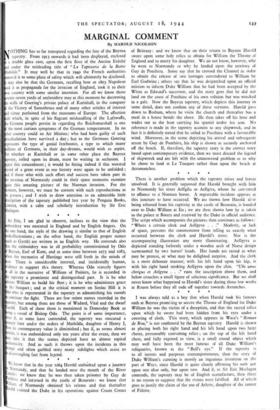Sir Eric, I am glad to observe, inclines to the
view that the broidery was executed in England and by English fingers. On e one hand,. the style of the drawing is similar to that of English ok-illustrations ; on the other hand, the English proper names uch as Gyrth) are written in an English way. He contends also at the embroidery was in all probability commissioned by Odo Bayeux, Earl of Kent, and at some time between ran- and 1083, hen the memories of Hastings were still fresh in the minds of en. There . is considerable internal, and incidentally human, idence to support this theory. Whereas Odo scarcely figures all in the narrative of William of Poitiers, he is accorded in e tapestry a prominent and distinguished part. It is he who rises William to build his fleet ; it is he who administers grace the banquet ; and at the critical moment on Senlac Hill it is o who is represented in the tapestry as admonishing his vassals continue the fight. There are few minor names recorded in the Pestry, but among them are those of Wadard, Vital and the dwarf urold. Each of these three is mentioned in Domesday Book as ng a vassal of Bishop Odo. The point is of some importance, cc if, as some have contended, the tapestry was executed a airy later under the orders of Mathilda, daughter of Henry I, en its contemporary value- is diminished ; but if, as seems almost rtain, it was embroidered only ten years after the event, then we ay take it that the scenes. depicted have an almost topical thenticity. And as such it throws upon the incidents in this range and often garbled story many sidelights which assist us disentangling fact from legend.
* * * *






















 Previous page
Previous page